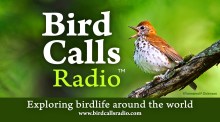A Lesson from the Gray Catbirds Spring Courtship Duet
I have long been an admirer of Catbirds. I remember distinctly when I first saw the chestnut red under-tail coverts and in a slightly wise way wondered why on earth the feathers there were so colorful. Don’t get me wrong, the color was very nice, but was hard to see, and I’m sure I did not think about the purpose they served for years. Gray Catbirds are Neotropic migrants and I admired them for that. They were also called half-hearties by an early mentor, Julio De La Torre; just this last February I saw a family group of 3 birds, in February in Fairfield, Connecticut, and we often get them on Christmas counts. I consider them a rather common southern New England bird and almost always find them when on the search for more exotic species. They forage in and inhabit, dense low scrubby vegetation and after the first few Catbirds for the year, I tend not to pay them too much attention.
Well I’m here to tell you that even a common bird species can put on a show and teach a lesson that will amaze the most jaded birder. I do consider myself an observer of birds rather than a list keeper and am happy to watch the activities of even a Robin for long periods. Yeah, and as an almost constant caregiver to an immense camera rig, does help to foster my observer status.

Gray Catbird (Dumetella carolinensis) 2 birds, courtship display, r. singing with fluffed body feathers, l. singing and displaying with fluffed feathers and by flashing chestnut red under-tail coverts at right bird, spring, woodland, East Rocks Park, New Haven, CT ©Townsend P. Dickinson. All Rights Reserved.
So to set the stage, Mardi and I were doing some early May birding at East Rocks Park, in New Haven and found the spring migrants to be rather sparse that particular day. Being bored but always hopeful, I walked my rig back long the river trail. I had the woods to myself; let’s just say that the trees were not dripping with colorful migrants as hoped and most birders had left the scene. As I walked along, I heard an attention getting bird call. I quickly spotted a singing Gray Catbird in the open woodland understory and almost immediately saw two more Catbirds close by. As I watched, one Catbird approached the singing bird, while the third bird kept its distance, although it was clearly attentive to the actions of the two approaching birds.
About this time I remembered that I had a camera rig with me and that I liked to take pictures of birds. So I aimed the Canon Super telephoto at the two active Catbirds just as they got close enough together to fit in the frame. Immediately I began to operate the shutter, I did not have time to check exposure or move the tripod or anything else but click off images. I did that steadily over the course of the next 81 seconds until there was only one bird left in the frame.
Now I know what I saw, you can see key parts of it too in the photos. There were two birds that approached each other and engaged in duet, while a third bird watched the proceedings. Let me also tell you what I don’t know. I do not know for certain the sexes of the dueting birds. Possibly it was two males displaying for the attention of the distant female observer. Each of the singing birds was going through an amazing, continually varied repertoire of squeaks, warbles, and long melodious phrases in a virtual nonstop torrent of sound at each other, at the same time. It was not loud but it was intense.

Gray Catbird (Dumetella carolinensis) 2 birds, courtship display, r. bird singing, l. begins singing and raises crown feathers, spring, woodland, East Rocks Park, New Haven, CT. ©Townsend P. Dickinson. All Rights Reserved.

Gray Catbird (Dumetella carolinensis) 2 birds, courtship display, l. bird hops away, fluffing body feathers and singing, r. attentive and singing, spring, woodland, East Rocks Park, New Haven, CT. ©Townsend P. Dickinson. All Rights Reserved.

Gray Catbird (Dumetella carolinensis) 2 birds, courtship display, l. bird hops away, fluffing body feathers and singing, r. attentive, hops after departing bird with fluffed body feathers and singing, spring, woodland, East Rocks Park, New Haven, CT. ©Townsend P. Dickinson. All Rights Reserved.
It was all I could do to keep focused on the two birds in the camera frame; they were the singers in the threesome. My impression was that the onlooker was clearly interested in the antics but its role in the activity is uncertain to me. Due to the magnification I could not fit the three birds in one frame. For reference, the third observer Catbird was up higher and 10-15 feet to the right of the dueting Catbirds.
While they were singing, one bobbed up and down, they both fluffed their feathers and pointed their bills up, one raised it’s crown feathers like a crest and one mooned the other with it’s CHESTNUT RED UNDER-TAIL COVERTS during the height of the display. This was a full-fledged courtship display.

Gray Catbird (Dumetella carolinensis) 2 birds, courtship display, spring, woodland, East Rocks Park, New Haven, CT. ©Townsend P. Dickinson. All Rights Reserved.

Gray Catbird (Dumetella carolinensis) 2 birds singing to each other, courtship display, spring, woodland, East Rocks Park, New Haven, CT. ©Townsend P. Dickinson. All Rights Reserved.
It seemed to me that almost as quickly as it started, it was over. The left member of the duet took wing towards the third bird and the remaining singer kept its perch and was calling towards the departing birds as they both flew off in the same directions. They were gone from sight in seconds.

Catbird (Dumetella carolinensis) 2 birds, courtship display, l. bird flies off toward third bird watching display, spring, woodland, East Rocks Park, New Haven, CT. ©Townsend P. Dickinson. All Rights Reserved.

Gray Catbird (Dumetella carolinensis) r. bird remains on branch calling at departed l. bird, courtship display, spring, woodland, East Rocks Park, New Haven, CT. ©Townsend P. Dickinson. All Rights Reserved.
I know now that it was unnecessary for me to know the purpose of the chestnut red under-tail coverts, the birds of course had no doubt what they were for. Once they shared that gift with me, my life was a tad richer. I could not believe my luck in witnessing this display and was even more thrilled to learn that I had gotten some records shots to share. I hope you agree.
(For those interested, I used a Canon 1DMkIV camera, Canon 500mm f4 IS lens, with a 1.4 converter giving me a magnification of 910mm. I also had Canon 580II flash with a Better Beamer flash multiplier all mounted on a gimbal head on a Gitzo carbon fiber tripod. Exposure was F8 and 1/500 sec, ISO 800. The camera would fire faster than the flash could recycle so some of the images do not have fill flash. The flash when firing was set at minus 1 and 2/3 stop exposure for fill. For the record, it was clear that the flash did not bother the courting birds. These are full frame, un-cropped images with some minor tonal corrections.)








Thanks – I enjoyed the interesting story and great photos! And I just saw catbirds this morning,
too, while out birding.
Great series of photos that help us understand Catbirds a bit better! 🙂
Very cool. I also tend to ignore the catbirds as background noise after awhile but it is always nice to be pleasantly surprised but what we might consider to be mundane. Thanks for sharing this great experience.
Nice description of behavior and very nice photos. I love catbirds and wish I’d heard/seen this, but am very, very appreciative for your documentation.